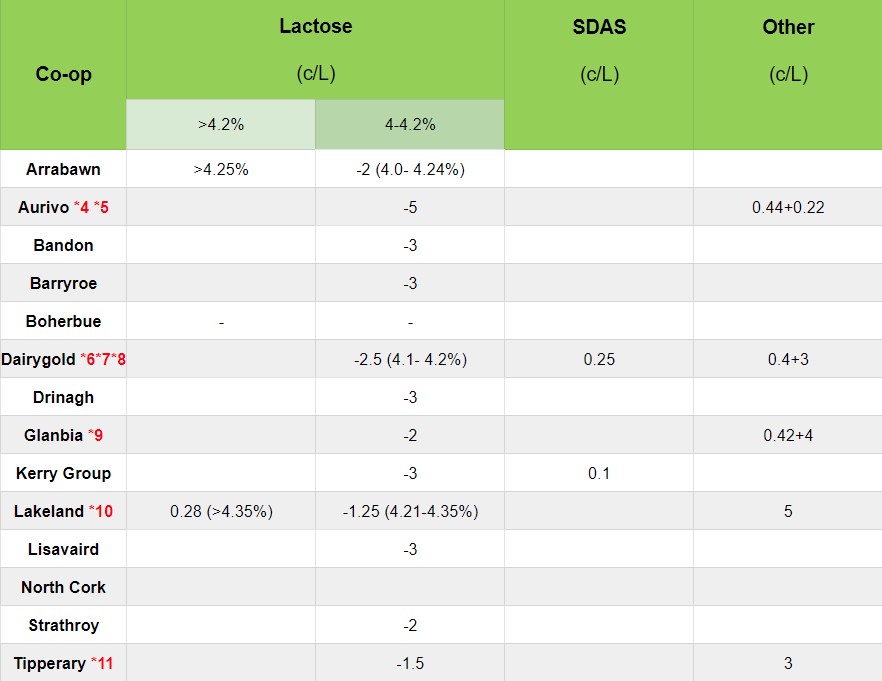The latest Milk Price Tracker – brought to you by AgriLand and the Irish Creamery Milk Suppliers’ Association (ICMSA) – details milk prices from the most significant Irish dairy co-ops for the month of January.
For each co-op, a green arrow indicates an increase in milk price (compared with the previous month); a blank space signifies no change; and a red arrow indicates a drop in milk price.
It should also be noted that, when calculating the base prices (on a c/L basis), we have used a fixed mass density factor – to convert from kilograms (kg) to litres (L).
The conversion factor used is 1.0297. In other words, 1L of milk corresponds to 1.0297kg of milk.
Moreover, the Irish c/L milk prices – quoted in the table – are base prices at the ‘standard’ fat and protein percentages cited by the vast majority of co-ops (i.e. 3.3% protein and 3.6% fat).
We also include base prices at ‘standard’ European criteria (i.e. 3.4% protein and 4.2% fat).
Moreover, we also include a column detailing what we describe as the ‘maximum attainable price’ – which is based on consistent levels of 3.3% protein and 3.6% fat.
- Have a somatic cell count (SCC) of less than 200,000;
- Have a total bacterial count (TBC) of less than 20,000;
- Have a lactose level of greater than 4.35%;
- Be a member of a Sustainability Dairy Assurance Scheme (SDAS); and
- Meet the criteria for an early calving bonus – offered by some co-ops.
This data has been sourced from suppliers’ milk statements and may be subject to updates/clarifications.
January 2020 prices
The milk prices in this table (below) are those quoted by co-ops for the month of January (2020).
This table (below) outlines some of the most significant bonuses offered by the various co-ops, as well as some of the key penalties that may be imposed.
The focus is on bonuses/penalties that have the greatest impact on a supplier’s ‘milk cheque’.
With regard to all of these tables (above), please see these explanatory notes (below).
- A blank space indicates that the base price applies, whereby there is no bonus or penalty;
- All bonus and penalty payments are based on manufacturing milk;
- *1 No penalties will apply to total bacteria counts (TBCs) of less than 75,001 in the months of January, February, November and December. Penalties will apply to TBCs in excess of 75,000 in those months;
- *2 The Glanbia TBC penalty system is based on points, whereby farmers are penalised based on the amount of points they received in that month over two TBC tests;
- *3 -0.75c/L penalty for somatic cell count (SCC) ranging between 351-400K;
- *4 Milk storage bonus. A storage bonus is available to suppliers with a minimum annual supply of 160,000L that have enough refrigerated storage capacity to cover seven milkings at peak production;
- *5 0.22c/L protein bonus is available for every 0.05% protein achieved, above the co-op average protein %, in an individual month;
- *6 0.25c/L includes 0.1c/L for the Sustainable Dairy Assurance Scheme (SDAS), 0.1c/L for sign up to milk recording (four per year) and 0.05c/L for sign up to milk recording and a Munster Bovine herd health scheme;
- *7 0.4c/L is the maximum bonus attainable by farmers who achieve the minimum requirements for six criteria (TBC, thermoduric, sediment, SCC, lactose and inhibitors);
- *8 3c/L unconditional early calving bonus for milk supplied in January;
- *9 0.42c/L payment on all milk supplied as their ‘Share of GI Profit’ and a 4c/L early calving bonus to be paid to creamery suppliers for January milk supplies;
- *10 5c/L early calving bonus if greater than 45% of May milk supplied in January;
- *11 3c/L early calving bonus if greater than 10% of May milk supplied in January.



